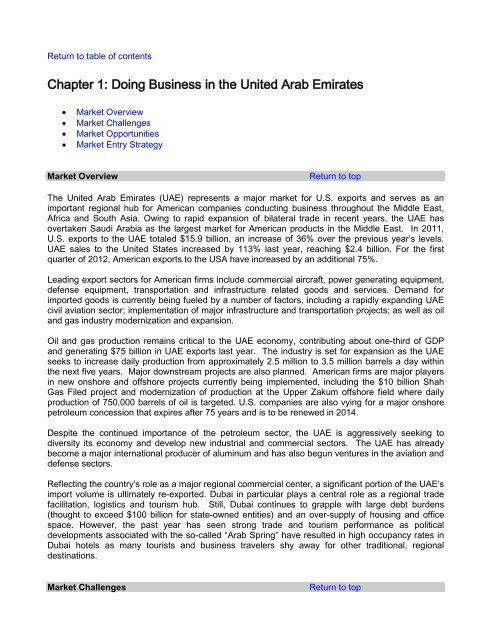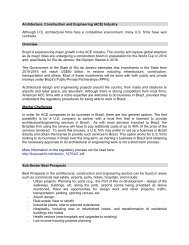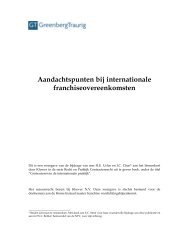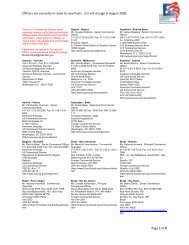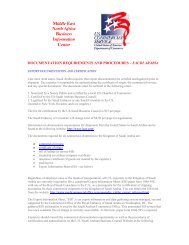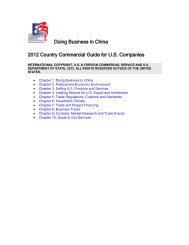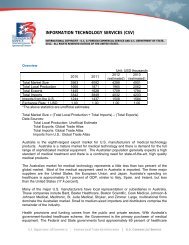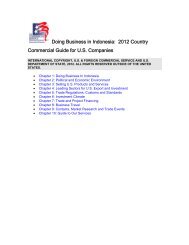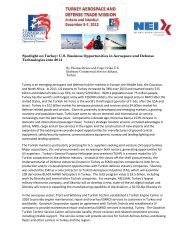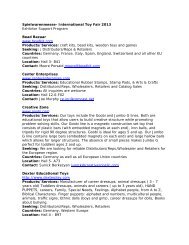UAE Country Commercial Guide 2012 - Export.gov
UAE Country Commercial Guide 2012 - Export.gov
UAE Country Commercial Guide 2012 - Export.gov
- TAGS
- export.gov
Create successful ePaper yourself
Turn your PDF publications into a flip-book with our unique Google optimized e-Paper software.
Return to table of contents<br />
Chapter 1: Doing Business in the United Arab Emirates<br />
• Market Overview<br />
• Market Challenges<br />
• Market Opportunities<br />
• Market Entry Strategy<br />
Market Overview Return to top<br />
The United Arab Emirates (<strong>UAE</strong>) represents a major market for U.S. exports and serves as an<br />
important regional hub for American companies conducting business throughout the Middle East,<br />
Africa and South Asia. Owing to rapid expansion of bilateral trade in recent years, the <strong>UAE</strong> has<br />
overtaken Saudi Arabia as the largest market for American products in the Middle East. In 2011,<br />
U.S. exports to the <strong>UAE</strong> totaled $15.9 billion, an increase of 36% over the previous year’s levels.<br />
<strong>UAE</strong> sales to the United States increased by 113% last year, reaching $2.4 billion. For the first<br />
quarter of <strong>2012</strong>, American exports to the USA have increased by an additional 75%.<br />
Leading export sectors for American firms include commercial aircraft, power generating equipment,<br />
defense equipment, transportation and infrastructure related goods and services. Demand for<br />
imported goods is currently being fueled by a number of factors, including a rapidly expanding <strong>UAE</strong><br />
civil aviation sector; implementation of major infrastructure and transportation projects; as well as oil<br />
and gas industry modernization and expansion.<br />
Oil and gas production remains critical to the <strong>UAE</strong> economy, contributing about one-third of GDP<br />
and generating $75 billion in <strong>UAE</strong> exports last year. The industry is set for expansion as the <strong>UAE</strong><br />
seeks to increase daily production from approximately 2.5 million to 3.5 million barrels a day within<br />
the next five years. Major downstream projects are also planned. American firms are major players<br />
in new onshore and offshore projects currently being implemented, including the $10 billion Shah<br />
Gas Filed project and modernization of production at the Upper Zakum offshore field where daily<br />
production of 750,000 barrels of oil is targeted. U.S. companies are also vying for a major onshore<br />
petroleum concession that expires after 75 years and is to be renewed in 2014.<br />
Despite the continued importance of the petroleum sector, the <strong>UAE</strong> is aggressively seeking to<br />
diversity its economy and develop new industrial and commercial sectors. The <strong>UAE</strong> has already<br />
become a major international producer of aluminum and has also begun ventures in the aviation and<br />
defense sectors.<br />
Reflecting the country’s role as a major regional commercial center, a significant portion of the <strong>UAE</strong>’s<br />
import volume is ultimately re-exported. Dubai in particular plays a central role as a regional trade<br />
facilitation, logistics and tourism hub. Still, Dubai continues to grapple with large debt burdens<br />
(thought to exceed $100 billion for state-owned entities) and an over-supply of housing and office<br />
space. However, the past year has seen strong trade and tourism performance as political<br />
developments associated with the so-called “Arab Spring” have resulted in high occupancy rates in<br />
Dubai hotels as many tourists and business travelers shy away for other traditional, regional<br />
destinations.<br />
Market Challenges Return to top


